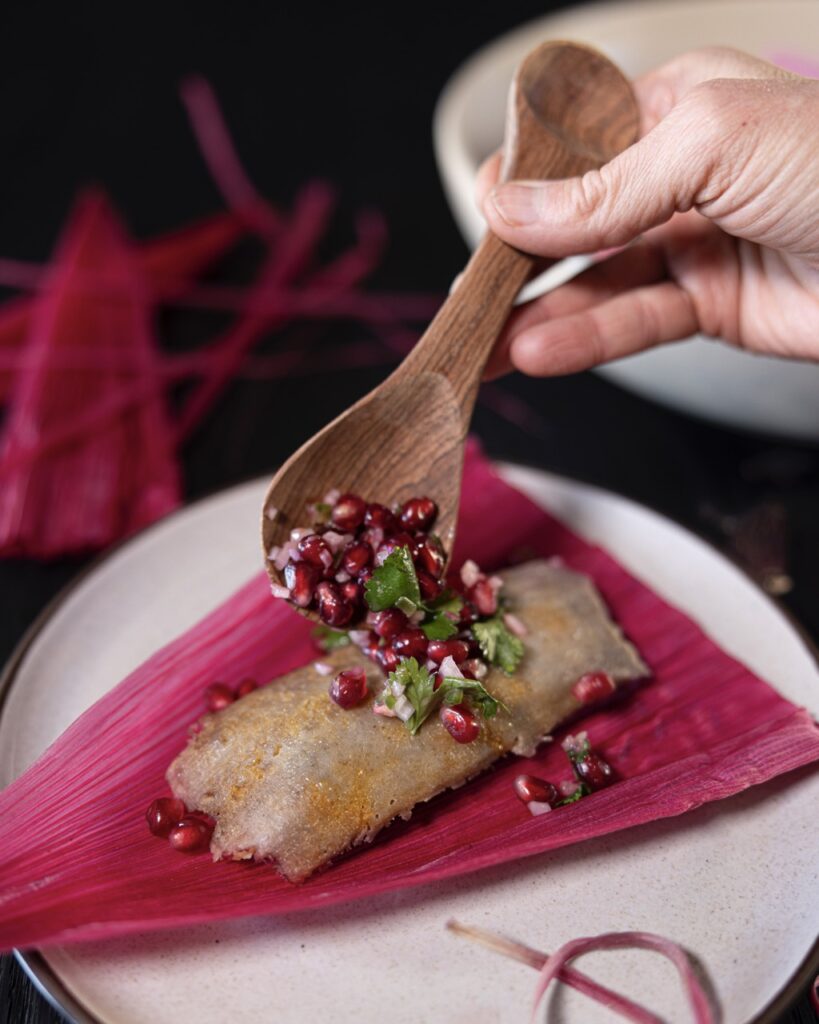In many parts of Latin America, and in Latino communities in the United States, tamales are an integral part of the winter holidays. Families and friends usually make them in big batches by forming a casual assembly line to spread the corn husk wrappers, fill them with masa and seasoned meats, and then tie the wrappers closed for steaming. This recipe for 30 tamales calls for Cochinita Pibil, a Yucatan specialty of pork marinated in achiote (annatto seeds) and citrus, then wrapped in banana leaves, and slow-cooked. Hibiscus flowers (“Jamaica” in Spanish) are usually used to make tart, ruby-red tea; here they dye the corn husks a bright pink. Shop for spices, masa, corn husks, as well as hibiscus at your local Latino market.

How Does Soaking Tamales Corn Husks in Hibiscus Tea Change the Flavor?
Soaking tamale corn husks in hibiscus tea or Jamaica, introduces a distinct tart and subtly floral complexity that you wouldn’t get with plain water. Besides the vibrant pink/red color hibiscus makes the corn husks, the tartness slightly transfers to the masa as the tamales steam. This means you end of with a dough that’s delicate as well as lightly flavored.
Print
Good Luck Tamales with Cochinita Pibil
- Yield: 30 Tamales, Serves 15 1x
Description
Making tamales into a good luck charm.
Ingredients
For the cochinita pibil:
- 3–4 large banana leaves
- 3 tbsp achiote seeds
- Juice of 2 oranges
- 2 tbsp sea salt
- 2 lb bone-in pork shoulder or butt
For the tamales:
- Dried hibiscus flowers (jamaica)
- 1 lb corn husks (45–50 pieces, depending on husk size)
- 3 cups lard
- 4 tsp baking powder
- 8 cups heirloom corn masa harina (preferably 1 full bag Masienda)
- 2 1/2 tbsp kosher salt
- 6–8 cups warm broth or water
Instructions
For the cochinita pibil:
- Briefly pass banana leaves over an open flame to make them flexible.
- Grind achiote seeds into a powder, then mix with orange juice and salt to form a liquidy paste.
- Rub marinade all over the pork and refrigerate for at least 1 hour, preferably overnight.
- Preheat oven to 200 degrees. Wrap pork in banana leaves, place in a baking dish, and bake for 6 hours.
- Unwrap pork, increase oven to 350 degrees, and bake for 30 minutes to develop a crust.
- Shred and serve warm. Store leftovers in the fridge for up to 4 days.
For the tamales:
- Make a hibiscus tea and soak corn husks in it for at least 10 minutes while you prepare the masa.
- Using a stand mixer with the whisk attachment or a hand mixer, whip lard on high until light and fluffy, about 5 minutes or until it reaches the texture of cake frosting.
- Add baking powder and gradually incorporate masa harina, mixing well.
- Slowly add 6 cups of warm broth or water, mixing to form a cohesive dough. Reserve the extra 2 cups to adjust moisture as needed. The masa should be well hydrated, not gritty, and have a creamy, airy texture that spreads easily.
- Taste the masa and add salt, whipping to incorporate. Use about 1 tsp per 3 cups masa if using unsalted liquid. Adjust if using salted broth.
- Gently wring out your corn husks and pat dry with a dishtowel.
- Arrange each husk with the wide end closest to you and the smooth side facing up.
- Using a spoon, spatula, or bench scraper, spread a thin, even layer of masa (about 2 ounces or 4 tablespoons) in a 3-inch by 5-inch area, leaving the narrow end uncovered.
- Add 1 ounce (1–2 tablespoon) of cochinita pibil to the center of the masa.
- Fold one side of the husk over the filling, then the other. Fold the bottom end toward the top. Optional: tie with a strip of corn husk to secure.
- Fill the bottom of a tamale steamer (or pot with a steamer basket) with water.
- Place tamales upright in the insert or basket and cover. Steam over medium-high heat for 75–90 minutes.
- Check for doneness: if the husk pulls away from the masa easily, they’re ready. More tamales may require longer cooking.
- Remove from heat and let rest, covered, for at least 15 minutes. Tamales will firm up as they cool.
Notes
The recipe calls for more corn husks than you’ll need but some may be too small or tear so it’s a good idea to have extras on hand.
Recipes by Chef Marijke Uleman
Story by Julia Platt Leonard
Styling by Jessie Baca
Photography by Tira Howard
Subscribe to TABLE Magazine‘s print edition.
